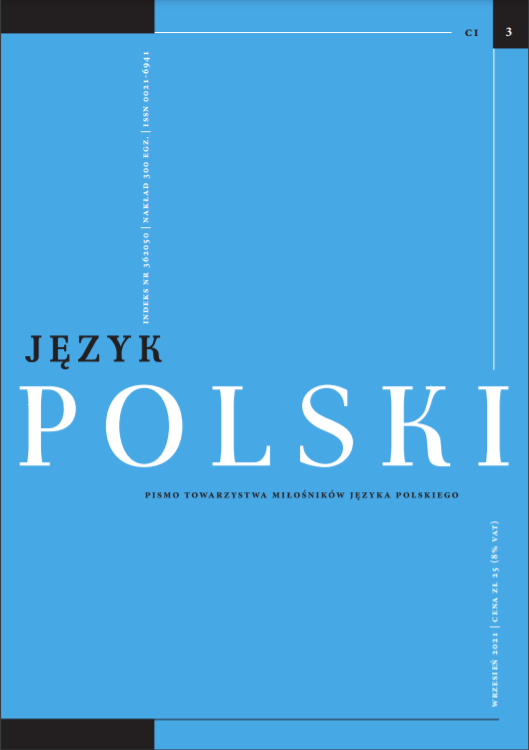Abstract
The paper discusses the Polish word plandemia (‘plandemic’) as an instance of a formal and conceptual blend, drawing on the conceptual integration theory as formulated by G. Fauconnier and M. Turner. Other new lexical items constituting a group of the so-called COVID vocabulary serve as a background to our analysis in that they all pertain to the linguistically created alternative model of the COVID-19 reality (competing with the message of the scientific community, of medical professionals, and of state authorities). Polish language users coin new derivatives and neosemanticisms referring to the pandemic reality (e.g., antycovidowiec, covidiota, kaganiec, koronasceptyk, koronaściema, koronabzdura). Those who display either a skeptical or a negative attitude towards the pandemic and the restrictions it has brought, employ the neologism plandemia in order to present their opinion that the SARS-CoV-2 virus is instrumental in realizing somebody’s plan and achieving a specific goal.
References
Alyeksyeyeva I.O., Chaiuk T.A., Galitska E.A. 2020: Coronaspeak as Key to Coronaculture: Studying New Cultural Practices Through Neologisms, „International Journal of English Linguistics”, vol. 10(6), s. 202–212 (doi: 10.5539/ijel.v10n6p202).
View on Google Scholar
Będkowska-Kopczyk A., Łaziński M. 2020: COVID-19 Vocabulary in Slavic, [w:] M.L. Greenberg (red.), Encyclopedia of Slavic Languages and Linguistics Online (doi: 10.1163/2589-6229_ESLO_COM_036254).
View on Google Scholar
Burkacka I. 2010: Klasyfikacja słowotwórcza nowszych zapożyczeń, „Linguistica Copernicana”, nr 2(4), s. 229–240.
View on Google Scholar
Cierpich-Kozieł A. 2020: Koronarzeczywistość – o nowych złożeniach z członem korona- w dobie pandemii, „Język Polski” C, z. 4, s. 102–117 (doi: 10.31286/JP.100.4.7).
View on Google Scholar
Cybulska A., Pankowski K. (red.) 2020: Pandemia koronawirusa w opiniach Polaków, Centrum Badania Opinii Społecznej, Warszawa.
View on Google Scholar
Fauconnier G., Turner M. 2002: The Way We Think: Conceptual Blending and the Mind’s Hidden Complexities, New York: Basic Books.
View on Google Scholar
Goddard C., Wierzbicka A. 2021: Semantics in the time of coronavirus: “Virus”, “bacteria”, “germs”, “disease” and related concepts, „Russian Journal of Linguistics”, vol. 25(1), s. 7–23 (doi: 10.22363/2687-0088-2021-25-1-7-23).
View on Google Scholar
Grzelka M. 2020: Attitudes toward vulnerable populations in the time of COVID-19: critical discourse analysis of Gazeta.PL online comment sections, „Society Register”, vol. 4(2), s. 121–132 (https://doi.org/10.14746/sr.2020.4.2.09).
View on Google Scholar
Jaworska S. 2021: Investigating media representations of the coronavirus in the UK, USA and Germany: what can a comparative corpus-based discourse analysis contribute to our understanding of the COVID-19 pandemic?, [w:] R.H. Jones (red.), Viral Discourse, Cambridge University Press, Cambridge, s. 26–36.
View on Google Scholar
Kardela H. 2006: (Nie)podobieństwo w morfologii: amalgamaty kognitywne, [w:] H. Kardela, Z. Muszyński, M. Rajewski (red.), Kognitywistyka 2. Podobieństwo, Wydawnictwo Uniwersytetu im. Marii Curie-Skłodowskiej, Lublin, s. 195–210.
View on Google Scholar
Kearney M.D., Chiang S.C., Massey P.M. 2020: The Twitter origins and evolution of the COVID-19 “plandemic” conspiracy theory, „Harvard Kennedy School (HKS) Misinformation Review” (doi: 10.37016/mr-2020-42).
View on Google Scholar
Libura A. 2007: Amalgamaty kognitywne. Powstanie i rozwój koncepcji integracji pojęciowej, [w:] A. Libura (red.), Amalgamaty kognitywne w sztuce, Universitas, Kraków, s. 11–66.
View on Google Scholar
Libura A. 2010: Teoria przestrzeni mentalnych i integracji pojęciowej: struktura modelu i jego funkcjonalność, Wydawnictwo Uniwersytetu Wrocławskiego, Wrocław.
View on Google Scholar
Mierzwińska-Hajnos A. 2017: Fuga daemonum, czyli dziurawiec jako amalgamat pojęciowy. Studium kognitywne, „Etnolingwistyka. Problemy Języka i Kultury”, nr 29(29), s. 31–45 (doi: 10.17951/et.2017.29.31).
View on Google Scholar
Nagórko A. 2007: Kontaminacje leksykalne – słowotwórstwo czy radosna tfurczość?, „Przegląd Humanistyczny”, z. 1, s. 203–210.
View on Google Scholar
Olza I., Koller V., Ibarretxe-Antuñano I., Pérez-Sobrino P., Semino E. 2021: The #ReframeCovid initiative: From Twitter to society via metaphor, „Metaphor and the Social World”, vol. 11(1), s. 99–121 (doi: 10.1075/msw.00013.olz).
View on Google Scholar
Pęzik P. 2020: Budowa i zastosowania korpusu monitorującego MoncoPL, „Forum Lingwistyczne”, nr 7, s. 133–150 (doi: 10.31261/fl.2020.07.11).
View on Google Scholar
Piller I., Zhang J., Li J. 2020: Linguistic diversity in a time of crisis: Language challenges of the COVID-19 pandemic, „Multilingua”, vol. 39(5), s. 503–515 (doi: 10.1515/multi-2020-0136).
View on Google Scholar
Roig-Marín A. 2020: English-based coroneologisms: A short survey of our Covid-19-related vocabulary, „English Today”, s. 1–3 (doi: 10.1017/S0266078420000255).
View on Google Scholar
Semino E. 2020a: ‘A fire raging’: Why fire metaphors work well for Covid-19 (online: https://www.researchgate.net/publication/342699168_%27A_fire_raging%27_Why_fire_metaphors_work_well_for_Covid-19, dostęp: 8 lutego 2021).
View on Google Scholar
Semino E. 2020b: “Not Soldiers but Fire-fighters” – Metaphors and Covid-19, “Health Communication”, vol. 36(1), s. 50–58 (doi: 10.1080/10410236.2020.1844989).
View on Google Scholar
Waszakowa K. 2007: Dynamika zjawisk słowotwórczych w tekście, „Z Polskich Studiów Slawistycznych”, seria 11: „Językoznawstwo”, s. 234–242.
View on Google Scholar
Waszakowa K. 2017a: Kognitywno-komunikacyjne aspekty słowotwórstwa. Wybrane zagadnienia opisu derywacji w języku polskim, Wydział Polonistyki Uniwersytetu Warszawskiego, Warszawa.
View on Google Scholar
Waszakowa K. 2017b: Composita kontaminacyjne jako rezultaty procesów analogii i anomalii, [w:] P. Łozowski, A. Głaz (red.), Route 66: from Deep Structures to Surface Meaning. A Festschrift for Henryk Kardela on his 66th Birthday, Wydawnictwo Uniwersytetu im. Marii Curie-Skłodowskiej, Lublin, s. 93–109.
View on Google Scholar
Waszakowa K. 2017c: Kontekstowe innowacje słowotwórcze w internetowych tekstach publicystycznych i w ich komentarzach. Studium przypadku, „LaMiCuS”, nr 1(1), s. 136–150.
View on Google Scholar
Waszakowa K. 2019: Internacjonalizacja w słowotwórstwie polszczyzny przełomu XX i XXI wieku jako przykład jed nostronnych kontaktów językowych, „Biuletyn Polskiego Towarzystwa Językoznawczego” LXXV, s. 179–194 (doi: 10.5604/01.3001.0013.6620).
View on Google Scholar
Włoskowicz W. 2020: Koronawirus jako problem językoznawstwa polonistycznego, „Poradnik Językowy”, nr 7–8, s. 98–111 (doi: 10.33896/PorJ.2020.7.8).
View on Google Scholar


